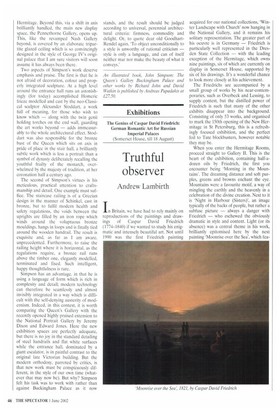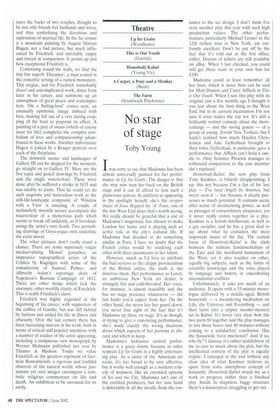Exhibitions
The Genius of Caspar David Friedrich: German Romantic Art for Russian Imperial Palaces (Somerset House, till 18 August)
Truthful observer
Andrew Lambirth
In Britain, we have had to rely mainly on reproductions of the paintings and drawings of Caspar David Friedrich (1774-1840) if we wanted to study his enigmatic and intensely beautiful art. Not until 1990 was the first Friedrich painting
acquired for our national collections, 'Winter Landscape with Church' now hanging in the National Gallery, and it remains his solitary representation. The greater part of his oeuvre is in Germany — Friedrich is particularly well represented in the Dresden State Collection — with the leading exception of the Hermitage, which owns nine paintings, six of which are currently on display in Somerset House, supported by six of his drawings. It's a wonderful chance to look more closely at his achievement.
The Friedrichs are accompanied by a small group of works by his near-contemporaries, such as Overbeck and Lessing, to supply context, but the distilled power of Friedrich is such that many of the other exhibits disappear into the background. Consisting of only 53 works, and organised to mark the 150th opening of the New Hermitage in St Petersburg, this is a refreshingly focused exhibition, and the perfect foil to Tate blockbusters, however notable they may be.
When you enter the Hermitage Rooms, proceed straight to Gallery II. This is the heart of the exhibition, containing half-adozen oils by Friedrich, the first you encounter being 'Morning in the Mountains'. The dreaming distance and soft purples, greens and browns enchant the eye. Mountains were a favourite motif, a way of mingling the earthly and the heavenly in a celebration of the divine creation. Next to it is 'Night in Harbour (Sisters)', an image typically of the backs of people, but rather a subfuse picture — always a danger with Friedrich — who eschewed the obviously dramatic in style and content. Light (or its absence) was a central theme in his work, brilliantly epitomised here by the next painting 'Moonrise over the Sea', which fea tures the backs of two couples, thought to be not only friends but husbands and wives, and thus symbolising the devotions and aspirations of married life. In the far corner is a mountain painting by August Mattias Hagen, not a bad picture, but much influenced by Friedrich, and inevitably empty and forced in comparison. It points up just how exceptional Friedrich is.
Continuing round the walls, we find the tiny but superb 'Dreamer', a man seated in the romantic setting of a ruined monastery. This elegiac, and for Friedrich remarkably direct and uncomplicated work, dates from later in his career, and summons up an atmosphere of great peace and contemplation. 'On a Sailing-boat' comes next, an unusually optimistic image imbued with love, making full use of a very daring cropping of the boat to pinpoint its effect. A painting of a pair of swans (which of course mate for life) completes the complex symbolism of love and companionship adumbrated in these works. Another unfortunate Hagen is joined by a Kruger portrait over each of the fireplaces.
The domestic scenes and landscapes of Gallery III can be skipped for the moment; go straight on to Gallery IV. Here are the five sepia and pencil drawings by Friedrich and the single watercolour. These were done after he suffered a stroke in 1835 and was unable to paint. That he could yet do such exquisite and meticulous work as the still-life/landscape composite of 'Window with a View' is amazing. A couple of melancholy moonlit scenes accompany the watercolour of a mysterious path which seems to break off suddenly, as if foreshadowing the artist's own death. Two perturbing drawings of Goya-esque owls underline the eerie mood.
The other pictures don't really stand a chance. There are some supremely vulgar mediaevalising Menzel gouaches, an impressive topographical series of the Crimea by Kugelgen with some of the romanticism of Samuel Palmer, and Albrecht Adam's reportage diary of Napoleon's Russian Campaign of 1812. There are other things which lack the visionary, other-worldly clarity of Friedrich. This is really Friedrich's show.
Friedrich was highly regarded at the beginning of his career, with supporters of the calibre of Goethe, but was left behind by fashion and ended his life in illness and obscurity. Over the last century there has been increasing interest in his work, both in terms of critical and popular attention, with a number of studies of the artist appearing, including a sumptuous new monograph by Werner Hofmann published last year by Thames & Hudson. Today we value Friedrich as the greatest exponent of German Romanticism, a rigorous and truthful observer of the natural world, whose passionate yet cool images encompass a symbolic religious commentary on life and death. An exhibition to be savoured for its rarity.







































































 Previous page
Previous page